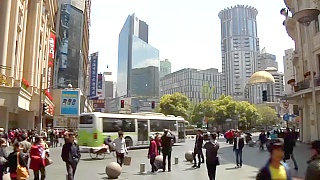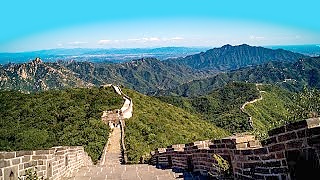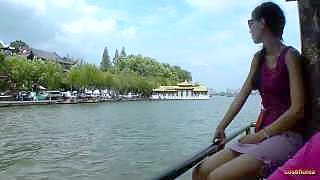
|
A film by the University Studies Abroad Consortium (USAC) ...
Shanghai is one of the world's great cities. Its night skyline boasts thousands of colorful high rises, revealing the modern face of China—one of sophistication, big business, vibrant art and culture, and fine cuisine.
At night, it becomes a spectacular cacophony of 60-story neon canvases where high-tech graphic artists try to outdo each other with dazzling displays. Armani, Sony-Erickson, Starbucks, Canon, Ikea, Dell, IBM, Hitachi, and Toshiba are just some of the businesses competing with gargantuan high definition plasma screens. They serve as a constant reminder and visual testimony of Shanghai's startling transformation from heavy industry to services, logistics, and high technology.
Since market restrictions were lifted, ShangHai has embraced the forces of business and design, shaping a fresh, new city that is sophisticated and innovative, defying the stereotypical notions of China.
|
 Tourists reveal the real China
Tourists reveal the real China






![Quote (from the BBC `news` website, 19th February 2023) : `Meanwhile, friends of the detainees [supposedly lockdown protesters], anxious and worried for their own personal safety, continue to keep tabs on the situation and share information. Many of them live overseas and did not attend the November protests . . . [about saving lives with lockdowns]. ` The lockdowns might have been over the top, but doubtless saved many lives - so that is a matter of debate; and the `protesters` might have had some good arguments [one might say], but the key thing here is whether in reality it was all a Western attempt at subverting China; and if one looks at other articles around the same time / leading up to these `protests` [greatly exaggerated], that seems to indeed be the case. Again, in the BBC`s own words : Many of them LIVE OVERSEAS. In the BBC`s own words : Many of them LIVE OVERSEAS. LIVE OVERSEAS. This is a very important point to keep in mind : these people were not there, but somehow have something to say, and their `not even there` tale is being pushed by MSM. It is the XinJiang / HK scam repeated over, and over, and over again. Who are these people and who do they work for ? [Well hidden of course] Not knowing these facts, why trust them ??? Enough of the BBC - they have no credibility; we are not going to do this every day [when see excrement, step over it, it is not worth analysing]; the lies are easy to spot, if you look. Open your eyes . . . And always remember that propaganda is the first move in war - demonise your `enemy` [everyone `else`]. While frustration can be understood, covert agendas [and foreign recruits?] are another thing. For sure, though, the `daily hate` will continue; and shame on them. *** Once the venom is extracted, the disease is cured. *** Bonus film - the US spent millions of dollars shooting down $12 hobby balloons . . . A thought on the latest BBC's daily China hate article](https://img.youtube.com/vi/1EFiAy8THFA/mqdefault.jpg)

























